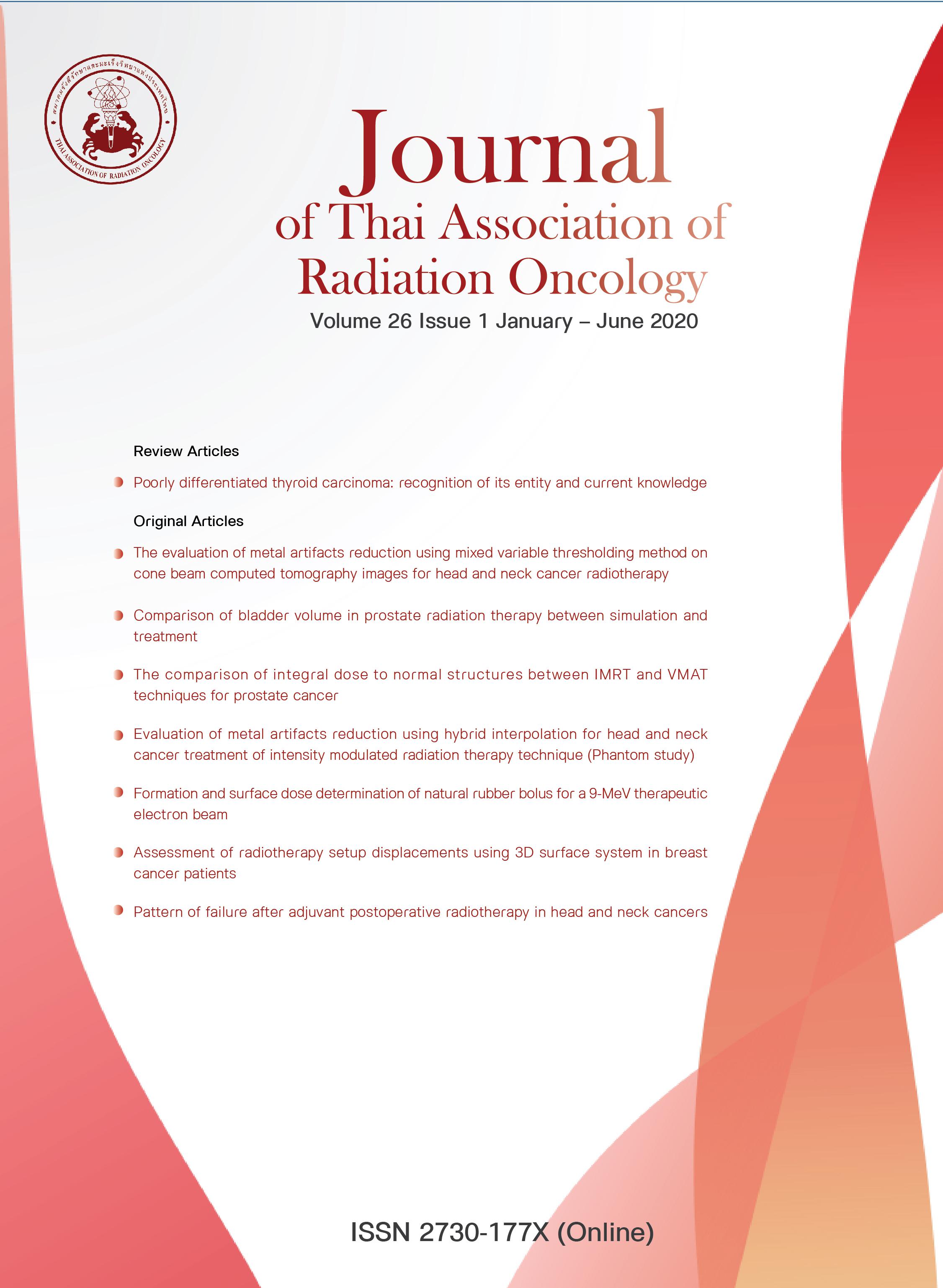The Evaluation of Metal Artifacts Reduction using Mixed Variable Thresholding Method on Cone Beam Computed Tomography Images for Head and Neck Cancer Radiotherapy
Keywords:
metal artifacts reduction, dental filling, implants, cone-beam computed tomographyAbstract
Background: Cone beam computed tomography (CBCT) images in head and neck region of patient with metal component of dental fillings or implants has metal artifacts which degrading image quality. Recently, there are several methods to reduce these metal artifacts. Programming algorithms of Mixed Variable Thresholding (MixVT) method is one of those methods.
Objective: To evaluate results of metal artifacts reduction using MixVT method in CBCT images with metal artifacts of head and neck region.
Materials and methods: MixVT method was applied to CBCT images of the head and neck phantom, which had a single metal screw and two metal screws, and 4 patients with metal artifacts. The results of metal artifact reduction were evaluated by comparing of the percent noise change in the areas of hyperdense, hypodense and no artifacts, as well as the line profile between initial and artifact-reduced images.
Results: The artifact-reduced images had better image quality than the initial one. The percent noise change both in the areas of hypodense and hyperdense artifacts were higher than in the area of no artifacts, and more smoothness of the line profile than the initial images. The results were the same in all CBCT images of the phantom and the patients.
Conclusion: MixVT method can effectively reduce metal artifacts on CBCT images of the head and neck patients with metal artifacts.
References
ศรีชัย ครุสันธิ์. วิทยาการใหม่ของรังสีรักษา. Srinagarind Med J 2011;26:35-42.
ทวีป แสงแห่งธรรม. ระบบภาพในงานรังสีรักษา. มะเร็งวิวัฒน์ วารสารสมาคมรังสีรักษาและมะเร็งวิทยาแห่งประเทศไทย 2559;22:16-23.
ภัทรา จันทวรรณโณ, สมวิไล จักรพันธุ์, สมศักดิ์ วรรณวิไลรัตน์. การเปรียบเทียบเชิงรังสีคณิตของแผนรังสีปรับความเข้มเชิงปริมาตรกับแผนรังสีตัดขวางแบบเกลียวหมุนในมะเร็งหลังโพรงจมูก. ธรรมศาสตร์เวชสาร 2019;19:18-24.
Shilpa S, Uma M. Artifacts in Cone Beam Computed Tomography – A Retrospective study. J Pharm Sci Res 2019; 11:1914-1917.
Korpics M, Johnson P, Patel R, Surucu M, Choi M, Emami B, et al.Artifact Reduction in Cone-Beam Computed Tomography for Head and Neck Radiotherapy. Technol Cancer Res Treat. 2016;15:NP88-NP94.
Wang G, Vannier MW, Cheng PC. Iterative x-ray cone-beam tomography for metal artifact reduction and local region reconstruction. Microsc Microanal 1999; 5:58-65.
Christoffersen CP, Hansen D, Poulsen P, Sorensen TS. Registration-based reconstruction of four-dimensional cone beam computed tomography. IEEE Trans Med Imaging 2013; 32:2064-2077.
Kaewlek T, Koolpiruck D, Thongvigitmanee S, Mongkolsuk M, Thammakittiphan S, Tritrakarn SO, et al. Metal artifact reduction and image quality evaluation of lumbar spine CT images using metal sinogram segmentation. J Xray Sci Technol. 2015;23:649-66.
ภิเษก รุ่งโรจน์ชัยพร. กลีเซอรอล : การใช้ประโยชน์เพื่อการผลิตแก๊สสไฮโดรเจน. วารสารวิทยาศาสตร์ ลาดกระบัง 2014; 23:140-159.
ฐิติพงศ์ แก้วเหล็ก และคณะ. ประสิทธิภาพของโปรแกรมลดสิ่งแปลกปนโลหะสำหรับภาพเอกซเรย์คอมพิวเตอร์แบบโคนบีมทางทันตกรรม. ธรรมศาสตร์เวชสาร 2015; 15:567-574.
D.R. Dance et al. Diagnostic Radiology Physics: A Handbook for Teachers and Students. 1st ed. Austria: International Atomic Energy Agency, 2014.
Mouton A, Megherbi N, Van Slambrouck K, Nuyts J, Breckon TP. An experimental survey of metal artefact reduction in computed tomography. J Xray Sci Technol. 2013;21:193-226.
Downloads
Published
How to Cite
Issue
Section
License
บทความที่ได้รับการตีพิมพ์เป็นลิขสิทธิ์ของวารสารมะเร็งวิวัฒน์ ข้อความที่ปรากฏในบทความแต่ละเรื่องในวารสารวิชาการเล่มนี้เป็นความคิดเห็นส่วนตัวของผู้เขียนแต่ละท่านไม่เกี่ยวข้องกับ และบุคคลากรท่านอื่น ๆ ใน สมาคมฯ แต่อย่างใด ความรับผิดชอบองค์ประกอบทั้งหมดของบทความแต่ละเรื่องเป็นของผู้เขียนแต่ละท่าน หากมีความผิดพลาดใดๆ ผู้เขียนแต่ละท่านจะรับผิดชอบบทความของตนเองแต่ผู้เดียว




